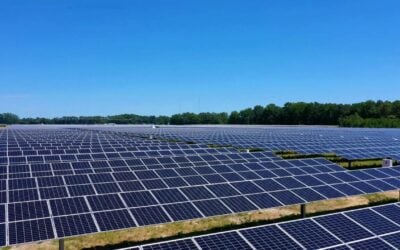
Regulators earlier this month approved a scheme to support grid-scale energy storage facilities, aligned with New York’s 6GW by 2030 policy target.
On 20 March, the New York State Public Service Commission (PSC) approved the draft Bulk Energy Storage Program Implementation Plan filed by the public-benefit corporation New York State Energy Research and Development Authority (NYSERDA).
Enjoy 12 months of exclusive analysis
- Regular insight and analysis of the industry’s biggest developments
- In-depth interviews with the industry’s leading figures
- Annual digital subscription to the PV Tech Power journal
- Discounts on Solar Media’s portfolio of events, in-person and virtual
Or continue reading this article for free
New York State defines ‘bulk’ energy storage as any facility of over 5MW output to the grid, and Commission chair Rory M. Christian noted this technology is “crucial as New York works to decarbonise our electric grid, manage increased energy loads, and optimise the integration and use of clean, renewable energy.”
NYSERDA staff submitted the plan in October last year, outlining the proposed structure of the Index Storage Credit Mechanism, a procurement programme for large-scale energy storage facilities in which the state would underwrite revenues against an agreed-upon strike price in the wholesale market.
The basic idea is to offer developers and investors sufficient remuneration and revenue certainty to make the business case for battery energy storage system (BESS) projects work while derisking the investment for New York’s consumers.
NYSERDA’s CEO Doreen Harris and VP for large-scale renewables Georges Sassine are due to participate in an Energy-Storage.news sponsored webinar this Thursday, 3 April at 2pm EST.
The webinar is the first in a two-part series. Harris and Sassine will discuss state policy and procurement commitments, offering insights into New York’s energy storage landscape and the integral role of storage in the state’s clean energy transition.
New York policy target of 6GW by 2030 achievable, PSC says
The Index Storage Credit Mechanism has been in the works for some time and was broadly welcomed by industry and experts when its design principles were revealed in 2023.
It came about through inclusion in the Energy Storage Roadmap 2.0, a document put together by NYSERDA and the New York Department of Public Service (the PSC’s service arm) to help guide New York toward the 6GW by 2030 target set by state governor Kathy Hochul.
The first version of the roadmap published in 2018 had successfully incentivised commercial and community-scale energy storage. However, developers felt there was still ‘missing money’ regarding large-scale standalone storage.
“It’s very difficult to finance merchant assets in a capacity market like the New York Independent System Operator (NYISO). You really need to have the ability to stack revenues like we do in California, and it’s a little different than Texas, in that the market doesn’t have that variability like it does in ERCOT, so it’s a tricky market,” Kelly Sarber, chief commercial officer of developer EPIC Star Energy told Energy-Storage.news in a recent interview.
“If you’re a bulk storage developer in New York State, you’re waiting for NYSERDA to issue this procurement,” Sarber, who is also a board member at trade group and technology accelerator NY-BEST, said.
The target is to assist New York in achieving 70% renewable electricity by the end of this decade, on the path to 100% emissions-free electricity by 2040. The PSC said the 6GW of energy storage would lower electricity system costs for New Yorkers by nearly US$2 billion.
NYSERDA is expected to host 4.7GW of competitive solicitations, beginning with annual tenders for a gigawatt of bulk storage this year.
As of April last year, New York had awarded around US$200 million to support 396MW of now-operational energy storage in the state, while around 581MW of storage is under contract or in construction. Incentive programmes under the first roadmap are still open, and NYSERDA seeks to award 323MW under those.
In total, that represents around 1.3GW of deployment across all scales from the first deployment, which together with the new solicitations would mean the state reaches its target on time.
Modifications to NYSERDA proposal
The PSC did, however, direct NYSERDA to modify the implementation plan before approving it.
Minimum maturity requirements for development projects which were set out in the PSC Order from June last year as it signed off on Roadmap 2.0 were geared toward non-bulk (i.e., distributed) storage procurements, and as NYSERDA pointed out in the draft plan, these may not align with development processes for bulk energy storage projects.
These maturity requirements largely focused on the status of interconnection agreement requests. NYSERDA’s draft Implementation Plan gave representative examples from other large-scale renewable energy procurements, where in some cases, bidding projects should have filed interconnection requests with NYISO, submitted a facilities study or equivalent to the independent system operator, and be able to show evidence of submitting permitting requests with applicable authorities having jurisdiction (AHJs) within 180 days of the NYSERDA request for proposals (RfP) being issued.
PSC meanwhile emphasised a position that maturity evaluation should be weighted toward projects further into the process of securing an interconnection agreement.
NYSERDA argued that requirements for interconnection agreements to be in place ahead of tenders were more appropriate for commercial and community-scale or residential projects than for bulk storage. NYSERDA said that active interconnection requests may be a more appropriate minimum maturity requirement but agreed that a signed interconnection agreement could benefit a project in the overall evaluation of maturity. The agency also said maturity conditions may be reassessed with each annual round of solicitations.
The PSC conceded that conditions could be reevaluated in subsequent tender rounds, but instructed that bidders of projects of less than 8-hour duration should have an active NYISO or utility interconnection request in place, while those of 8-hour or more should demonstrate a reasonable pathway to obtaining an interconnection agreement within the proposed timeline, as partners at law firm Hodgson Russ explained in a recent blog on its corporate website.
Among other modifications, the PSC said NYSERDA should submit a proposal for calculating the value of multi-day energy storage resources and establish caps for storage resources of 2-hour duration.
Sign up for Energy-Storage.news’ sponsored webinar with NYSERDA, ‘Advancing Energy Storage in New York: A Two-Part Series‘ taking place this Thursday, 3 April 2025, at 2pm EST.
This article has been amended from its original form to more accurately reflect the nature of PSC’s modifications to the NYSERDA draft plan.






